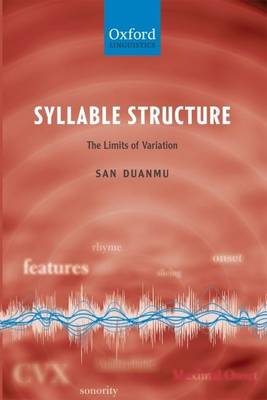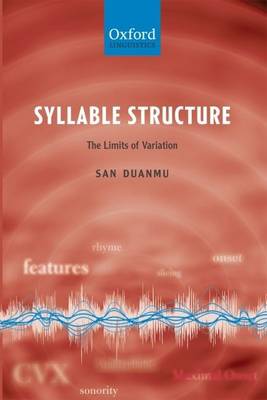
- Retrait gratuit dans votre magasin Club
- 7.000.000 titres dans notre catalogue
- Payer en toute sécurité
- Toujours un magasin près de chez vous
- Retrait gratuit dans votre magasin Club
- 7.000.0000 titres dans notre catalogue
- Payer en toute sécurité
- Toujours un magasin près de chez vous
55,95 €
+ 111 points
Format
Description
This book looks at the range of possible syllables in human languages. The syllable is a central notion in phonology, yet basic questions about it remain poorly understood and phonologists are divided on even the most elementary issues. For example, the word city has been syllabified as ci-ty (the 'maximal onset' analysis), cit-y (the 'no-open-lax-V' analysis), and cit-ty (the 'geminate C' analysis).
San Duanmu explores and clarifies these and many other related issues through an in-depth analysis of the entire lexicons of several languages. Some languages, such as Standard and Shanghai Chinese, have fairly simple syllables, yet a minimal difference in syllable structure has led to a dramatic difference in tonal behavior. Other languages, such as English, German, and Jiarong, have long consonant clusters and have been thought to require very large syllables: San Duanmu shows that the actual syllable structure in these languages is much simpler. He bases his analyses on quantitative data, paying equal attention to generalizations that are likely to be universal. He shows that a successful analysis of the syllable must take into account several theories, including feature theory, the Weight-Stress Principle, the size of morpheme inventory, and the metrical representation of the syllable.
San Duanmu's clear exposition will appeal to phonologists and advanced students and will provide a new benchmark in syllabic and prosodic analysis. He also offers an answer to the intriguing question: how different can human languages be?
San Duanmu explores and clarifies these and many other related issues through an in-depth analysis of the entire lexicons of several languages. Some languages, such as Standard and Shanghai Chinese, have fairly simple syllables, yet a minimal difference in syllable structure has led to a dramatic difference in tonal behavior. Other languages, such as English, German, and Jiarong, have long consonant clusters and have been thought to require very large syllables: San Duanmu shows that the actual syllable structure in these languages is much simpler. He bases his analyses on quantitative data, paying equal attention to generalizations that are likely to be universal. He shows that a successful analysis of the syllable must take into account several theories, including feature theory, the Weight-Stress Principle, the size of morpheme inventory, and the metrical representation of the syllable.
San Duanmu's clear exposition will appeal to phonologists and advanced students and will provide a new benchmark in syllabic and prosodic analysis. He also offers an answer to the intriguing question: how different can human languages be?
Spécifications
Parties prenantes
- Auteur(s) :
- Editeur:
Contenu
- Nombre de pages :
- 304
- Langue:
- Anglais
Caractéristiques
- EAN:
- 9780199581108
- Date de parution :
- 05-04-10
- Format:
- Livre broché
- Format numérique:
- Trade paperback (VS)
- Dimensions :
- 231 mm x 155 mm
- Poids :
- 464 g

Les avis
Nous publions uniquement les avis qui respectent les conditions requises. Consultez nos conditions pour les avis.






